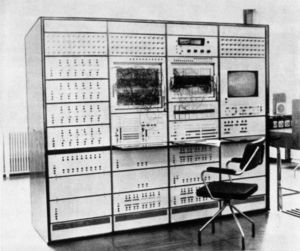
Hybrid computer
Encyclopedia

Analog computer
An analog computer is a form of computer that uses the continuously-changeable aspects of physical phenomena such as electrical, mechanical, or hydraulic quantities to model the problem being solved...
s and digital
Digital
A digital system is a data technology that uses discrete values. By contrast, non-digital systems use a continuous range of values to represent information...
computer
Computer
A computer is a programmable machine designed to sequentially and automatically carry out a sequence of arithmetic or logical operations. The particular sequence of operations can be changed readily, allowing the computer to solve more than one kind of problem...
s. The digital component normally serves as the controller and provides logical operations, while the analog component normally serves as a solver of differential equations.
In general, analog computers are extraordinarily fast, since they can solve most complex equations at the rate at which a signal traverses the circuit, which is generally an appreciable fraction of the speed of light. On the other hand, the precision
Precision (computer science)
In computer science, precision of a numerical quantity is a measure of the detail in which the quantity is expressed. This is usually measured in bits, but sometimes in decimal digits. It is related to precision in mathematics, which describes the number of digits that are used to express a...
of analog computers is not good; they are limited to three, or at most, four digits of precision.
Digital computers can be built to take the solution of equations to almost unlimited precision, but quite slowly compared to analog computers. Generally, complex equations are approximated using iterative numerical methods which take huge numbers of iterations, depending on how good the initial "guess" at the final value is and how much precision is desired. (This initial guess is known as the numerical seed for the iterative process.) For many real-time
Real-time computing
In computer science, real-time computing , or reactive computing, is the study of hardware and software systems that are subject to a "real-time constraint"— e.g. operational deadlines from event to system response. Real-time programs must guarantee response within strict time constraints...
operations, the speed of such digital calculations is too slow to be of much use (e.g., for very high frequency phased array radars or for weather calculations), but the precision of an analog computer is insufficient.
Hybrid computers can be used to obtain a very good but relatively imprecise
Accuracy and precision
In the fields of science, engineering, industry and statistics, the accuracy of a measurement system is the degree of closeness of measurements of a quantity to that quantity's actual value. The precision of a measurement system, also called reproducibility or repeatability, is the degree to which...
'seed' value, using an analog computer front-end, which is then fed into a digital computer iterative process to achieve the final desired degree of precision. With a three or four digit, highly accurate numerical seed, the total digital computation time necessary to reach the desired precision
Significant figures
The significant figures of a number are those digits that carry meaning contributing to its precision. This includes all digits except:...
is dramatically reduced, since many fewer iterations are required. One of the main technical problems to be overcome in hybrid computers is minimizing digital-computer noise in analog computing elements and ground systems.
Consider that the nervous system
Nervous system
The nervous system is an organ system containing a network of specialized cells called neurons that coordinate the actions of an animal and transmit signals between different parts of its body. In most animals the nervous system consists of two parts, central and peripheral. The central nervous...
in animals is a form of hybrid computer. Signals pass across the synapses from one nerve cell to the next as discrete (digital) packets of chemicals, which are then summed within the nerve cell in an analog fashion by building an electro-chemical potential until its threshold
Threshold potential
The threshold potential is the membrane potential to which a membrane must be depolarized to initiate an action potential.It often can be between −40 and -55 mV, but it can vary based upon several factors...
is reached, whereupon it discharges and sends out a series of digital packets to the next nerve cell. The advantages are at least threefold: noise within the system is minimized (and tends not to be additive), no common grounding system is required, and there is minimal degradation of the signal even if there are substantial differences in activity of the cells along a path (only the signal delays tend to vary). The individual nerve cells are analogous to analog computers; the synapses are analogous to digital computers.
Note that hybrid computers should be distinguished from hybrid systems. The latter may be no more than a digital computer equipped with an analog-to-digital converter
Analog-to-digital converter
An analog-to-digital converter is a device that converts a continuous quantity to a discrete time digital representation. An ADC may also provide an isolated measurement...
at the input and/or a digital-to-analog converter
Digital-to-analog converter
In electronics, a digital-to-analog converter is a device that converts a digital code to an analog signal . An analog-to-digital converter performs the reverse operation...
at the output, to convert analog signals for ordinary digital signal processing, and conversely, e.g., for driving physical control systems, such as servomechanism
Servomechanism
thumb|right|200px|Industrial servomotorThe grey/green cylinder is the [[Brush |brush-type]] [[DC motor]]. The black section at the bottom contains the [[Epicyclic gearing|planetary]] [[Reduction drive|reduction gear]], and the black object on top of the motor is the optical [[rotary encoder]] for...
s.
External references
- A New Tool For Science By Daniel Greco and Ken Kuehl

